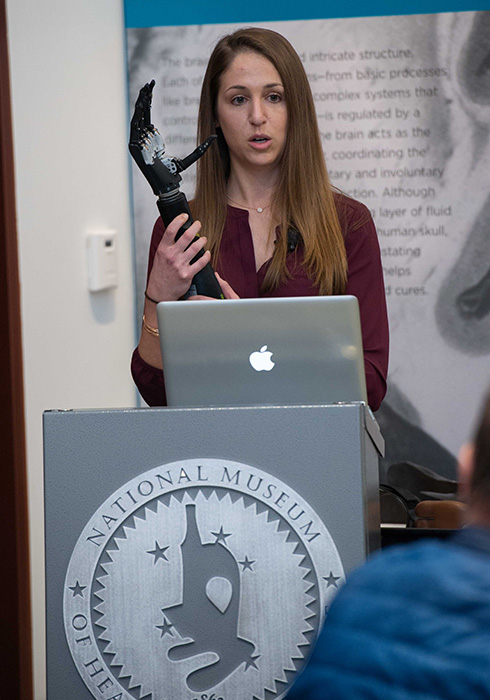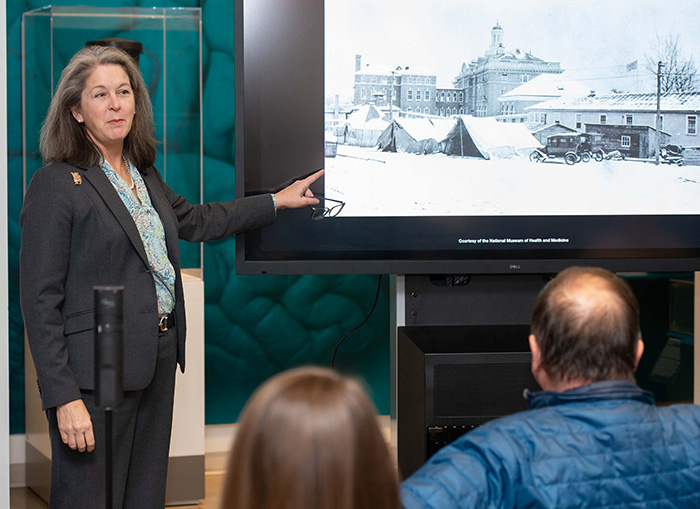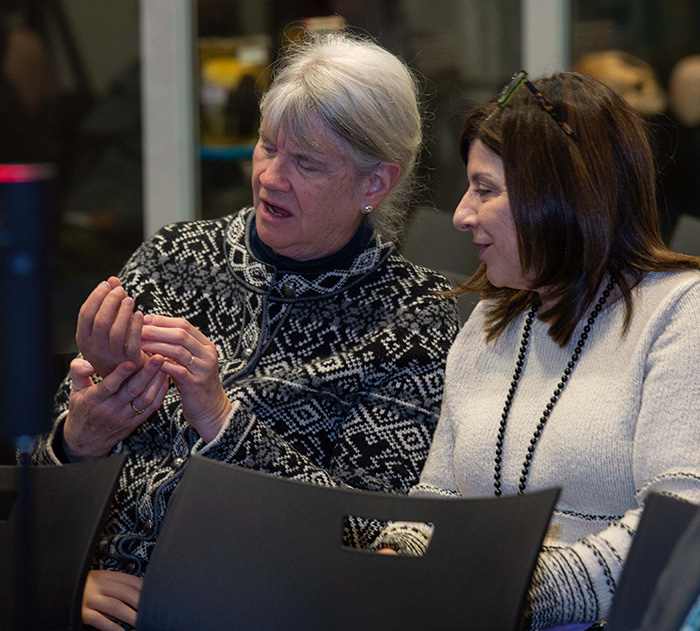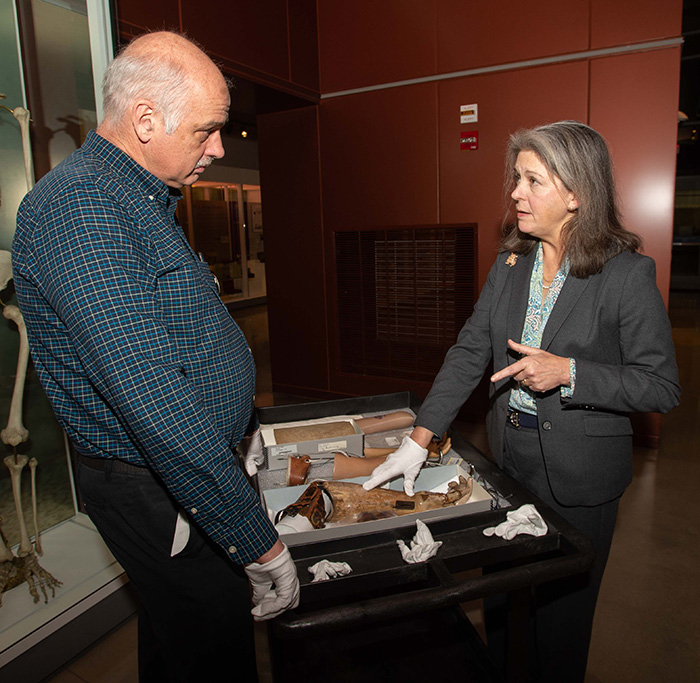Innovation Leads to State-of-the-Art Rehabilitation for Service Members at Walter Reed National Military Medical Center
By Lauren Bigge
NMHM Public Affairs Coordinator

Lisa Prasso, D.P.T., physical therapist for the Department of Rehabilitation at the Military Advanced Treatment Center, holds an innovative prosthetic arm as she tells the National Museum of Health and Medicine's (NMHM's) audience about injured service members undergoing rehabilitation at Walter Reed National Military Medical Center during the Jan. 22, 2019, Medical Museum Science Café titled "The State of Physical Therapy at Walter Reed National Military Medical Center" at NMHM in Silver Spring, Md. (National Museum of Health and Medicine photo by Matthew Breitbart/Released)
Physical therapists from Walter Reed National Military Medical Center's Extremity Trauma Amputation Center of Excellence (EACE) and Military Advanced Training Center (MATC) shared with the National Museum of Health and Medicine's (NMHM) Jan. 22 Medical Museum Science Café audience how innovations are transforming the lives of service members undergoing rehabilitation after they have suffered severe injuries and amputations.
Dr. Andrea E. Crunkhorn, chief of clinical affairs at EACE, said physical therapy and occupational therapy were not professions during World War I. Once Walter Reed General Hospital opened in 1909, the Surgeon General of the Army decided physical therapy should be included in patient care. He asked Mary McMillan to start the first physical therapy program in the United States at Walter Reed. Her troops were known as reconstruction aides. They served both in France and in the United States, and became known as the American Physical Therapy Association.
"Walter Reed has always been associated with research, education, and training," Crunkhorn said. "In 1923, Walter Reed graduated the first class of physical therapists in the United States. The occupational therapy program happened in the same space as the physical therapy." They worked with patients on focusing on tasks, such as building fine motor skills or functional skills. Patients were equipped with adaptive prosthetics for functional use. Inspired by the Walter Reed physical therapy program, Col. Emma Vogel pioneered physical therapy programs in 10 additional Army facilities throughout the United States during World War II.
Civil War and World War II-era prosthetics from NMHM's collections were on display during the presentation. Historical Collections manager Alan Hawk showed attendees artifacts, including a right forearm, a right hand with a cosmetic glove, and an arm used by Cpl. Robert Oscar Burkhardt, a patient at Walter Reed General Hospital between 1945 and 1947.
Prosthetics have evolved, both in terms of comfortable functionality and appearance. In contemporary medicine they can look life-like. "We still have artists coming in to Walter Reed right now," Crunkhorn explained. "They work with the patients, and they paint the cosmetic covers individually by hand–down to the fingernails–so it looks like it's a part of you."
Dr. Lisa Prasso, physical therapist at the Military Advanced Treatment Center within the Department of Rehabilitation, said that 2009 marked the first quadruple amputee to survive a war zone blast. "The world of prosthetics was forced to evolve, and so was rehabilitation," she said. In 1997, the first fully-controlled microprocessor leg became available. "Walter Reed Army Medical Center was the first to use it in rehabilitation," Prasso said. She also noted that the first power knee entered the market in 2006. It is the only power knee that allows amputees to perform a range of functions.
As more service members returned from battlefields with amputations, a task force established three centers of excellence for extremity trauma: one at Brooke Army Medical Center in Fort Sam Houston, Texas, one at Naval Medical Center San Diego, and a third at the MATC at Walter Reed Bethesda. The Centers of Excellence provide state-of-the art in-patient and out-patient rehabilitation.
In 2007, Walter Reed's MATC opened at then-Walter Reed Army Medical Center. That was the year of America's highest casualty numbers for Operation Iraqi Freedom, with 216 amputees, and 60 of those service members had multiple limb amputations.
"The facility was fit with state-of-the-art equipment; it allowed our amputees at all levels to return to as optimal function as possible," Prasso said. The building included a gait lab with a computer system, specialized cameras, and a mechanism in the floor to gather data on amputees' progress in walking, as well as a virtual reality environment consisting of a video simulation system with a treadmill embedded into a moving platform so amputees can gain confidence with their adaptive devices. Innovations in rehabilitation for service members didn't end there.
Between 2008 and 2010, two prosthetic companies partnered to develop the first prosthesis featuring an electronically-operated thumb that mimics natural human hand movement. It allows an amputee to drink a bottle of water or shake a hand.
Since 2013, service members undergoing rehabilitation at the newly established Walter Reed National Military Medical Center who want to participate in adaptive sports ranging from skiing to weight lifting to basketball can use specialized knees, feet, leg braces, grips, and more to train so they can get back to high-functioning lifestyles.
"The National Museum of Health and Medicine cares for material culture and archival records related to the history of rehabilitation in military medicine that spans from the Civil War until the present to include collections related to rehabilitation at WRNMMC," said Andrea Schierkolk, NMHM Public Programs Manager. "We were pleased to share the current practices being used to address the challenges faced by physical therapists in providing state-of-the-art care for service members with amputations and extremity trauma."
NMHM's Medical Museum Science Cafés provide forums for informal talks that connect the mission of the Department of Defense museum with the public. NMHM was founded as the Army Medical Museum in 1862 and is a division of the Defense Health Agency Research and Development Directorate. For more information on upcoming events, call (301) 319-3303 or visit www.medicalmuseum.mil.






